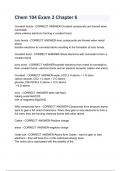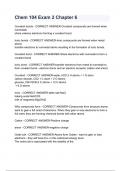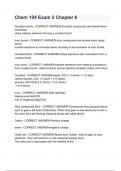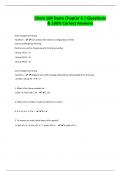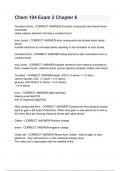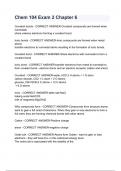Chem 104 chapter 6 - Study guides, Class notes & Summaries
Looking for the best study guides, study notes and summaries about Chem 104 chapter 6? On this page you'll find 20 study documents about Chem 104 chapter 6.
All 20 results
Sort by
Chem 104 Exam 2 Chapter 6 With correct scholarly solution
Chem 104 Exam 2 Chapter 6 With correct scholarly solution
Chem 104 Exam 2 Chapter 6 with complete solution
Chem 104 Exam Chapter 6 | Questions & 100% Correct Answers
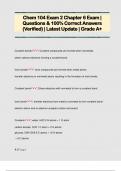
-
Chem 104 Exam 2 Chapter 6 Exam | Questions & 100% Correct Answers (Verified) | Latest Update | Grade A+
- Exam (elaborations) • 20 pages • 2024
-
- $11.49
- + learn more
Covalent bonds: Covalent compounds are formed when nonmetals share valence electrons forming a covalent bond. Ionic bonds: Ionic compounds are formed when metal atoms transfer electrons to nonmetal atoms resulting in the formation of ionic bonds. Covalent bond: Share electrons with nonmetal to form a covalent bond Ionic bond: transfer electrons from metal to nonmetal to form covalent bond - electron donor and an electron acceptor (cation and anion) Covalent: water, H2O 2 H atoms + 1 O ato...

-
Chem 104 Exam 2 Chapter 6 complete solution 2023/2024
- Exam (elaborations) • 13 pages • 2024
-
- $7.99
- + learn more
Covalent bonds - CORRECT ANSWER-Covalent compounds are formed when nonmetals share valence electrons forming a covalent bond. Ionic bonds - CORRECT ANSWER-Ionic compounds are formed when metal atoms transfer electrons to nonmetal atoms resulting in the formation of ionic bonds. Covalent bond - CORRECT ANSWER-Share electrons with nonmetal to form a covalent bond Ionic bond - CORRECT ANSWER-transfer electrons from metal to nonmetal to form covalent bond - electron donor and an electron ac...
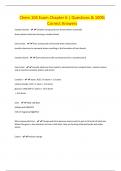
-
Chem 104 Exam Chapter 6 | Questions & 100% Correct Answers
- Exam (elaborations) • 14 pages • 2024
-
- $12.99
- + learn more
Covalent bonds - Covalent compounds are formed when nonmetals share valence electrons forming a covalent bond. Ionic bonds - Ionic compounds are formed when metal atoms transfer electrons to nonmetal atoms resulting in the formation of ionic bonds. Covalent bond - Share electrons with nonmetal to form a covalent bond Ionic bond - transfer electrons from metal to nonmetal to form covalent bond - electron donor and an electron acceptor (cation and anion) Covalent - water, H2O 2 H atoms + 1 ...
Chem 104 Exam 2 Chapter 6
Chem 104 Exam 2 Chapter 6.
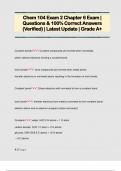
-
Chem 104 Exam 2 Chapter 6 Exam | Questions & 100% Correct Answers (Verified) | Latest Update | Grade A+
- Exam (elaborations) • 20 pages • 2024
-
- $10.99
- + learn more
Covalent bonds: Covalent compounds are formed when nonmetals share valence electrons forming a covalent bond. Ionic bonds: Ionic compounds are formed when metal atoms transfer electrons to nonmetal atoms resulting in the formation of ionic bonds. Covalent bond: Share electrons with nonmetal to form a covalent bond Ionic bond: transfer electrons from metal to nonmetal to form covalent bond - electron donor and an electron acceptor (cation and anion) Covalent: water, H2O 2 H atoms + 1 O ato...

How much did you already spend on Stuvia? Imagine there are plenty more of you out there paying for study notes, but this time YOU are the seller. Ka-ching! Discover all about earning on Stuvia

